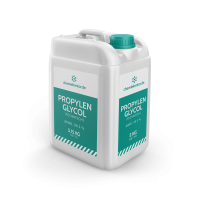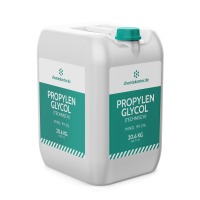Buying propylene glycol - what to consider:
What is propylene glycol used for?
Propylene glycol, also known as 1,2-propanediol, is used in a variety of applications due to its diverse solvent and emulsifying properties. In addition to water and glycerin, propylene glycol as a component of fog fluids provides the desired dense fog for mostly short-term show effects or for highlighting light beams.
Its use in the tobacco industry is particularly widespread. Together with glycerin, it serves as a humectant in cigarette and water pipe tobacco. However, 1,2-propanediol is mainly associated with e-cigarettes. Propylene glycol is the main ingredient in the corresponding e-liquids. The propylene glycol offered at chemiekontor.de in its technical state should not be used for this purpose. On the other hand, the propylene glycol we offer mixed with water is a proven antifreeze. Thus, car radiators, stationary cooling systems or aircraft surfaces can be effectively protected against ice formation.
It is also used for the production of brake fluids, heat transfer fluids, alkyd and polyester resins or as a solvent for greases, oils, waxes, resins and dyes, as well as for the production of polypropylene glycols, provided the given purity is required.
What are the properties of the product?
Technical propylene glycol is a colorless and odorless liquid at room temperature, also known by the chemical name propane-1,2-diol. Its melting point, depending on the concentration, is between -59 and -1.5 °C, its boiling point is 184 - 189 °C, and its flash point is 99 °C. Thus, the compound forms flammable vapor-air mixtures only above this temperature.
It should be noted that the substance has a spontaneous ignition temperature above 400 °C and a decomposition temperature above 200 °C. Propylene glycol has a density of 1.035 - 1.04 g/m3 and is completely soluble in water. It is also miscible with ethanol, but not with fatty oils.
How is 1,2-propanediol produced?
Generally, propylene glycol is produced industrially by hydrolysis of propylene oxide. Manufacturers use two different processes for this. Some use a high-temperature process without catalysis at 200 - 220°C, while others use a catalytic process at 150 - 180°C in the presence of an internal exchange resin or small amounts of sulfuric acid or alkalis.
The final product of both processes contains 20% 1,2-propanediol, which is purified by rectification, 1.5% dipropylene glycol and smaller amounts of other polypropylene glycols. Furthermore, it is possible to produce 1,2-propanediol from glycerol, which is a by-product from biodiesel production.




